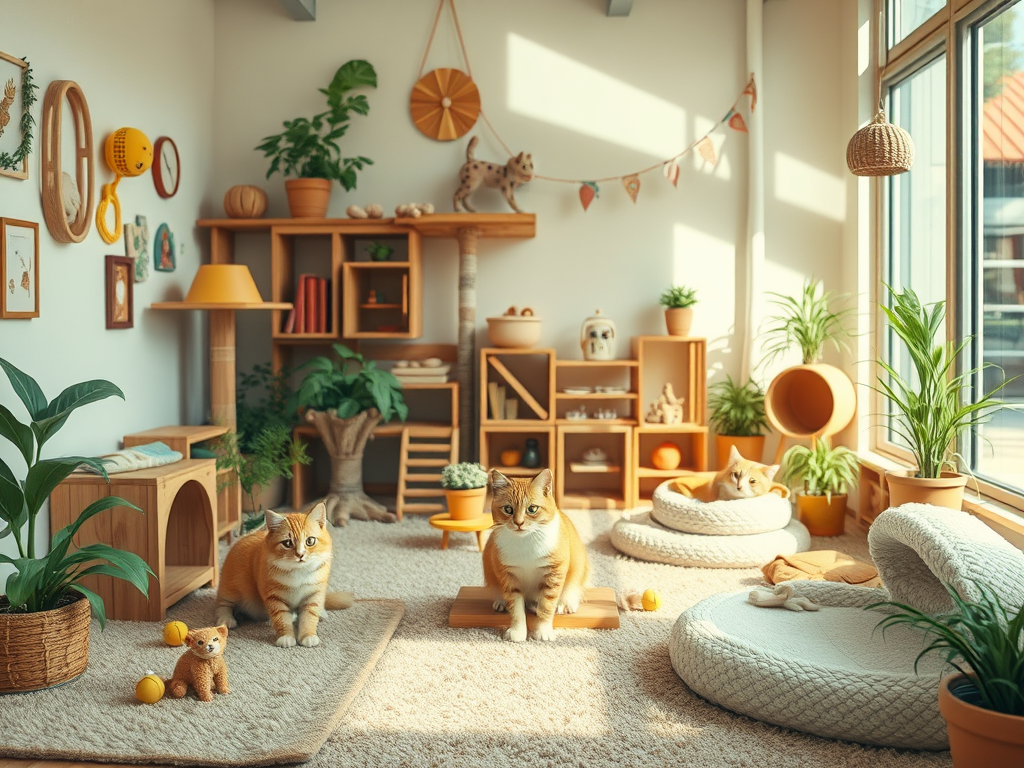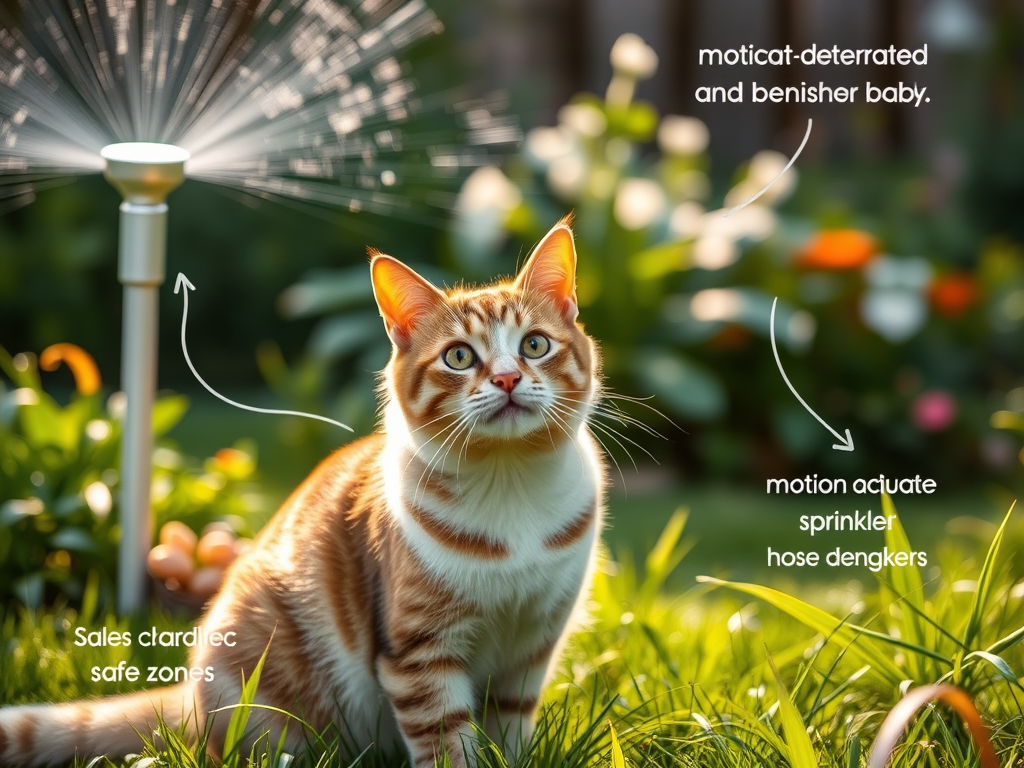Effective Strategies to Reduce Your Cat’s Natural Hunting Behavior
Create a Safe Indoor Space to Minimize Your Cat’s Hunting Impact: Recognizing that cats have an inherent hunting instinct is crucial to understanding their behavior. This instinct is deeply rooted in their ancestry, making it vital to channel these behaviors in a safe manner. One effective approach is to cultivate a secure indoor environment that caters to their natural instincts while ensuring the protection of local wildlife. By crafting spaces filled with engaging activities and sensory stimulation, you can keep your feline friend mentally and physically satisfied, ensuring they do not pose a risk to unsuspecting animals outside your home.
Incorporating interactive toys into your cat’s playtime can vastly improve their indoor hunting experience. Toys such as feather wands, laser pointers, and motorized mice are excellent choices that can keep your cat entertained for long durations. These engaging toys simulate natural hunting behaviors, allowing your cat to stalk, chase, and pounce, which are essential for their mental and physical health. Not only do these toys provide entertainment, but they also help your pet expend energy positively, contributing to their overall well-being and happiness.
Transform your living space into an exciting feline playground by creating obstacle courses filled with diverse structures like boxes, tunnels, and elevated shelves. This makeshift jungle gym encourages your cat to explore and engage in physical activities, allowing them to climb, jump, and investigate different environments. Cats are naturally curious, and by providing varied spaces for exploration, you can mimic their wild instincts, making them feel as if they are on a thrilling adventure in a DIY safari.
Never underestimate the benefits of puzzle feeders. These innovative feeding devices challenge your cat mentally while mimicking the effort they would typically expend while hunting. By integrating treat-dispensing puzzles into your cat’s daily routine, you can keep their minds active and engaged, providing a fun and rewarding experience. This approach not only entertains your pet but also encourages healthier eating habits as they learn to ‘work’ for their treats, promoting a more fulfilling mealtime experience.
Prioritize playtime as an essential component of your cat’s daily routine. Engaging in social interactions through play is vital for strengthening your bond with your feline companion. Make it a point to set aside dedicated play sessions where you use the same toys they enjoy during solo play. This shared experience not only alleviates any built-up frustration your cat may harbor but also deepens your connection, transforming playtime into a meaningful and enjoyable experience for both you and your cat.
Creating a stimulating indoor environment for your cat is not only possible but also fun with a little creativity. Your home can evolve from a simple shelter into an adventurous landscape that meets their natural hunting instincts while ensuring their safety from outdoor dangers. With thoughtful planning and a willingness to engage, you can foster a happy and fulfilled indoor cat.

Unlock New Adventures for Your Cat Through Leash Training
Embracing leash training can significantly expand your cat’s horizons and allow for safe outdoor exploration. While walking is often associated with dogs, cats, too, can enjoy the thrill of outdoor adventures with the right training and patience. By slowly introducing your feline friend to a harness and leash, you grant them the chance to experience the wonders of nature while remaining secure and safe.
Start your leash training journey with a well-fitted harness that ensures comfort for your cat. It’s crucial to allow your pet time to familiarize themselves with the harness before attempting to put it on. Let them sniff and inspect the harness to minimize any anxiety they may feel. Gradually introducing the harness at their own pace will help foster positive associations, making the overall process smoother and more enjoyable for your cat.
Once your cat feels comfortable wearing the harness, attach a lightweight leash and begin practicing indoors. This familiar setting will help them adjust to the sensation of the leash while simultaneously building their confidence. Take your time, and anticipate some initial resistance; patience is key in helping your cat acclimate to this new and exciting experience.
When it comes time for your cat’s first outdoor adventure, choose a calm and secure location, such as your backyard or a quiet park. Ensure that the area has minimal traffic and distractions so your cat feels safe. Start with short outdoor sessions to avoid overwhelming your pet, gradually extending the duration as they become more comfortable exploring their new surroundings.
Supervised outdoor time enriches your cat’s life, allowing them to enjoy the sights, sounds, and scents of nature without posing a risk to local wildlife. Imagine the joy on your cat’s face as they encounter new experiences in a safe environment. This bonding time not only enhances their quality of life but also strengthens your relationship, creating cherished memories together.
Real-life stories from fellow cat owners can serve as great motivation. Many have expressed initial doubts about their cats taking to leash walking, but through consistency and positive reinforcement, they’ve achieved remarkable success. Celebrate each small victory as a step toward broadening your cat’s horizons while ensuring their safety and well-being.
Incorporating leash training into your cat’s routine facilitates a harmonious blend of outdoor enjoyment and wildlife protection. This balanced approach allows your cat to explore the great outdoors while fostering a sense of security in their environment.
Enhance Your Cat’s Safety with Outdoor Spaces: Explore the Benefits of Catios
Outdoor cat enclosures, commonly known as catios, provide an optimal solution for adventurous cats yearning for outdoor experiences without the inherent risks. These secure spaces allow your feline companions to bask in nature while ensuring their safety and the protection of local wildlife from potential harm.
Whether you choose to build or purchase a catio, the design can be customized to suit your available space and budget. Options range from simple balcony enclosures to more elaborate backyard constructions. The primary objective should always be to create a structure that is escape-proof, as safety is paramount in providing a secure environment for your cat.
When designing your catio, consider integrating multiple levels and cozy hiding spots. Cats thrive in environments that offer vertical spaces and areas to retreat. By incorporating platforms, ramps, and hammocks, you can transform a basic enclosure into a stimulating haven that closely resembles their natural habitat.
Enhancing the sensory experience within the catio is also beneficial. Introduce elements such as cat grass, scratching posts, or logs to create an engaging environment filled with diverse textures and enticing scents. This sensory enrichment will keep your cat entertained and content while enabling them to relish the outdoors in a controlled and safe manner.
Regular maintenance is essential for ensuring the safety and longevity of your catio. Routinely inspect the structure for any signs of wear and tear, including the integrity of the mesh, the framework, and the locks. Cats are naturally inquisitive and may test the boundaries of their enclosure, so keeping it in optimal condition is vital for their safety and overall well-being.
With a catio, your feline friend can enjoy sunbathing, climbing, and observing wildlife without posing a threat to local ecosystems. They can relax in the sun and watch birds from the safety of their outdoor haven, remaining content while wildlife stays protected from harm.

Implementing Effective Behavioral Training Techniques to Curb Hunting Instincts
Training your cat to reduce their hunting behaviors may appear daunting, but with the right techniques, it can be a manageable and rewarding task. The first step is to comprehend their natural instincts and the behaviors that drive them to hunt, which is essential for developing effective training strategies.
Leverage technology to support your training endeavors. Consider utilizing motion-activated deterrents, such as sprinklers or noise-makers, to establish boundaries that discourage hunting without disrupting other activities. Strategically zoning your yard into safe areas can redirect your cat’s focus away from potential prey, ensuring they remain engaged in safer activities.
Positive reinforcement is a cornerstone of modifying your cat’s behavior. Reward them for non-hunting actions with treats or affection. For example, if your cat responds to your call or refrains from pursuing a potential target, offer them a tasty treat or extra love. This method encourages them to repeat desirable behaviors while gradually reducing their instinctive urge to hunt.
Incorporating clicker training can also be a powerful tool in your behavior modification toolkit. This technique involves associating a distinct sound with positive actions, allowing your cat to connect their behavior with rewards. By clicking when they exhibit desired behavior, you reinforce good habits and clarify your expectations, making it easier for your cat to understand what you want from them.
For more personalized guidance, consider consulting with feline behavior specialists. They can provide tailored advice and insights that address specific challenges you may face, helping you and your cat coexist harmoniously while respecting the local wildlife.
The goal of using deterrents and training isn’t punishment but rather guiding your cat toward behaviors that prioritize their safety and the protection of the environment. With consistency and patience, you can successfully redirect their instincts, leading to safer outdoor interactions for both your cat and local wildlife.
Adopting Feeding Strategies to Reduce Hunting Drives in Cats
The type of food you provide and the methods you use for feeding can have a significant impact on your cat’s hunting instincts. Interestingly, a well-fed cat may still exhibit hunting behaviors; however, the way you feed them can effectively help mitigate this drive.
Free feeding, where food is available at all times, might not be beneficial for every cat. Instead, consider implementing a structured feeding schedule. By establishing consistent mealtimes, your cat may be less inclined to hunt, as they will learn to associate food with specific times of the day, reducing their instinct to seek out prey.
Interactive feeding strategies can be transformative for your cat’s behavior. Utilizing food puzzles or dispensers can replicate the act of hunting, requiring your cat to ‘work’ for their meals. This approach not only keeps them mentally engaged but also channels their energy into a positive outlet, allowing their natural instincts to be expressed in a safe and controlled manner.
Furthermore, it’s important to consider the nutritional content of the food you provide. A diet that is high in protein and low in carbohydrates aligns more closely with a cat’s natural dietary needs, potentially leading to a decrease in hunting behaviors. Collaborating with a veterinarian to customize the diet can ensure your cat’s nutritional requirements are effectively met.
Lastly, offering a variety of food types can satisfy your cat’s inherent curiosity and appetite for novelty. Alternating between dry kibble, wet food, and raw diets can keep mealtime interesting, reducing the temptation to seek excitement beyond their food dish and helping them stay engaged and satisfied.
Feeding strategies extend beyond mere sustenance; they are a powerful tool for managing your cat’s behavior. By adjusting how and what you feed them, you can effectively diminish their inclination to hunt while ensuring they remain satisfied and healthy.

Fostering Community Responsibility for Cat Conservation
Cats are delightful companions, and as their caretakers, we bear the responsibility of ensuring they coexist peacefully with local wildlife. By embracing community initiatives and personal accountability, we can significantly reduce the ecological impact of free-roaming cats.
Engaging with local conservation groups is an excellent avenue for staying informed about wildlife-friendly practices. Many communities offer educational workshops for cat owners, addressing the ecological consequences of allowing cats to roam freely and presenting solutions to mitigate these effects.
Consider starting or joining neighborhood discussions or social media groups focused on responsible pet ownership. Sharing resources, tips, and experiences can cultivate a wildlife-conscious community, creating a supportive environment for all pet owners, which can lead to better practices for pet care.
One proactive approach is to establish cat-friendly zones within communal gardens or parks. These designated areas can include enclosures or supervised play spaces, ensuring a safe environment for both cats and wildlife. This collaborative effort enhances awareness and promotes positive interactions between pets and nature, fostering harmony in the community.
Incorporating family-friendly initiatives, such as sticker campaigns or educational contests for children and teens, can raise awareness about responsible pet ownership and the importance of living in harmony with nature.
Lead by example at home by applying the strategies you’ve learned. Whether it’s leash training, building catios, or adjusting feeding practices, demonstrating your commitment to a balanced relationship between your cat and the environment can inspire others to take similar actions.
By combining individual efforts with community-based initiatives, we can create a supportive network that harmonizes our cats’ needs with ecological stewardship. Together, we can cherish our pets while respecting and protecting the wild spaces around us.
The Article: Minimize Your Cat’s Hunting Impact Appeared First On Unity Pets.
The Article Minimize Hunting Impact of Your Cat Effectively Was Found On https://limitsofstrategy.com





Comments are closed